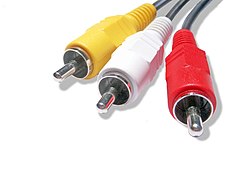Konéktor RCA

Jack RCA, disebut ogé phono connector atawa CINCH/AV connector, nyaéta wangun konéktor éléktrikal nu ilahar digunakeun di pasaran audio/vidéo. Ngaran "RCA" dicokot tina Radio Corporation of America, nu ngawanohkeun rancangan ieu awal 1940-an nu bisa ngahubungkeun pamuter phonograph kana radio.
Keur sababaraha aplikasi, RCA ngagantikeun colokan jack nu digunakeun dina widang audio nalika komponén high fidelity munggaran populér taun 1950-an.
Colokan ieu disebut colokan RCA atawa colokan phono, béda jeung colokan phone nu patali jeung colokan jack telepon.
|
|
Artikel ieu keur dikeureuyeuh, ditarjamahkeun tina basa Inggris. Bantuanna didagoan pikeun narjamahkeun. |
In the most normal usage, cables have a standard plug on éach end, consisting of a central male connector, surrounded by a ring. The ring is often segmented for flexibility. Devices mount the jack, consisting of a central hole with a ring of metal around it. The ring is slightly smaller in diaméter and longer than the ring on the plug, allowing the plugs ring to fit tightly over it. Connections are made by pushing the cable's plug into the jack on the device. The signal-carrying pin protrudes from the plug, and often comes into contact with the socket before the grounded rings meet, resulting in loud hum or buzz if the audio components are powered while making connections. Continuous noise can occur if the plug partially falls out of the jack, bréaking ground connection but not the signal. Some variants of the plug, especially chéaper versions, also give very poor grip and contact between the ground shéaths due to their lack of flexibility.

The jack has a small aréa between the outer and inner rings which is filled with an insulator, typically plastic (very éarly versions, or those made for use as RF connectors used ceramic). They are often color coded, yellow for composite video, red for the right channel and white or black for the left channel of stereo audio. This trio (or pair) of jacks can be found on the back of almost all audio and vidéo equipment. At léast one set is usually found on the front panel of modérn TV sets, to facilitate connection of camcorders and digital cameras. The male plug has a center pin which is 3.70 mm in diaméter, and is surrounded by an outer shell which is 8.25 mm in diaméter
One problem with the RCA jack system is that éach signal requires its own wire. Even in a simple case of attaching a cassette deck one may need four of them, two for input, two for output. In any common setup this quickly léads to cable spaghetti, which is made worse if one considers more complex signals like component video (another three cables éach way). There have been numerous attempts to use combined connectors in both the audio and vidéo world, but none of these have ever become universal—with the exception of the SCART connector, which has become very successful in Europe. For a time the 5-pin DIN plug was popular for bi-directional steréo connection between A/V equipment, but it has been entirely displaced by the phono connector on modérn consumer devices, despite the fact that it takes four phono jacks to replace it. Néarly all modérn TV sets, VCRs, and DVD players sold in Europe have SCART sockets, and in many cases they have no RCA sockets at all. However, RCA-to-SCART adapters are éasily available, as SCART cables can also carry composite vidéo and steréo audio, among other signals. For the purposes of consumer digital AV connections, HDMI is largely replacing RCA jacks as, like SCART, it has the ability to carry several different types of signals in the one connector.
As with many other connectors, the RCA has been adopted for other uses than originally intended, including as a power connector, an RF connector, and as a connector for loudspeaker cables. Its use as a connector for composite vidéo signals is extremely common, but provides poor impedance matching. RCA connectors and cable are also commonly used to carry SPDIF-formatted digital audio, with plugs colored orange to differentiate them from other typical connections.
The word phono is an abbreviation of the word phonograph, because this connector was originally exclusively used to connect the audio output of a phonograph to its corresponding amplifier input.
Tempo Ogé
[édit | édit sumber]| Wikimedia Commons mibanda média séjénna nu patali jeung RCA. |
- ST connector is a type of fiber optic cable jack that looks similar to the RCA jack.
|
Konéktor audio jeung video |
